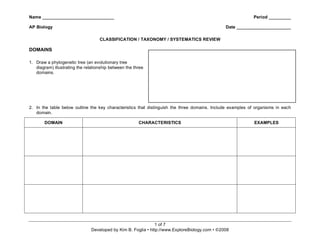More Related Content
Similar to Classification review2008 (20)
Classification review2008
- 1. Name _____________________________ Period _________
AP Biology Date ______________________
CLASSIFICATION / TAXONOMY / SYSTEMATICS REVIEW
DOMAINS
1. Draw a phylogenetic tree (an evolutionary tree
diagram) illustrating the relationship between the three
domains.
2. In the table below outline the key characteristics that distinguish the three domains. Include examples of organisms in each
domain.
DOMAIN CHARACTERISTICS EXAMPLES
1 of 7
Developed by Kim B. Foglia • http://www.ExploreBiology.com • ©2008
- 2. Name _____________________________ AP Biology
EUKARYOTIC KINGDOMS
3. In the table below outline the key characteristics that distinguish the four kingdoms of the Domain Eukarya by making notes on
the following: (1) mode of nutrition, (2) presence or absence of cell wall, (3) method(s) of reproduction, and (4) any other notable
characteristic.
KINGDOM MODE OF NUTRITION CELL WALL REPRODUCTION OTHER
2 of 7
Developed by Kim B. Foglia • http://www.ExploreBiology.com • ©2008
- 3. Name _____________________________ AP Biology
EUKARYOTES: PLANTS
4. Draw a phylogenetic tree illustrating the relationship
between the four groups of land plants. Note the key
characteristic that distinguishes each major branch.
5. In the table below outline the key characteristics that distinguish the four groups of land plants by making notes on the following:
(1) presence or absence of vascular system, (2) dominance of gametophyte vs. sporophyte, (3) mode of reproduction, and (4)
any other notable characteristic.
GAMETOPHYTE &
PLANT GROUP VASCULAR SYSTEM REPRODUCTION OTHER
SPOROPHYTE
3 of 7
Developed by Kim B. Foglia • http://www.ExploreBiology.com • ©2008
- 4. Name _____________________________ AP Biology
EUKARYOTES: ANIMALS
6. Complete the diagram below: (1) label the key advance at each evolutionary branch point, and (2) explain the significance of
each evolutionary advance.
Cnidaria Nematoda Annelida Echinoderm
Porifera Platyhelminthes Mollusca Arthropoda Chordata
8.
7.
6.
5.
4.
3.
2.
1.
Ancestral Protist
4 of 7
Developed by Kim B. Foglia • http://www.ExploreBiology.com • ©2008
- 5. Name _____________________________ AP Biology
7. In the table below outline the key characteristics that distinguish the groups of the Kingdom Animalia by making notes on the
following: (1) type of symmetry, (2) presence of coelom, (3) presence of segmentation, (4) soft body vs. exoskeleton vs. endoskeleton,
and (5) any other notable characteristic (e.g., proto- vs. deutersotome, etc.). Also include examples of organisms in each group.
SEGMENT- EXAMPLES/
ANIMAL GROUP SYMMETRY COELOM BODY OTHER
ATION COMMON NAME
5 of 7
Developed by Kim B. Foglia • http://www.ExploreBiology.com • ©2008
- 6. Name _____________________________ AP Biology
EUKARYOTES: ANIMALS: VERTEBRATES
8. In the table below outline the key characteristics that distinguish the five subgroups of the Vertebrates by making notes on the
following: (1) body structure & type of body covering, (2) structure used for gas exchange, (3) structure of heart, (4) ectotherm vs.
endotherm, (5) mode of fertilization (internal vs. external), (6) mode of development (internal vs. external & what kind of egg), and
(7) any other notable characteristics. Also include examples of organisms in each group.
VERTEBRATE GAS ECTO- VS. FERTILIZ- DEVELOP-
BODY HEART OTHER EXAMPLES
SUBGROUP EXCHANGE ENDOTHERM ATION MENT
6 of 7
Developed by Kim B. Foglia • http://www.ExploreBiology.com • ©2008
- 7. Name _____________________________ AP Biology
EUKARYOTES: ANIMALS: VERTEBRATES: MAMMALS
9. In the table below outline the key characteristics that distinguish the 3 subgroups of the Mammals by making notes on the
following: (1) mode of development, (2) care of the young, (3) any other notable characteristic. Also include examples of
organisms in each subgroup.
MAMMAL SUBGROUP CHARACTERISTICS EXAMPLE
7 of 7
Developed by Kim B. Foglia • http://www.ExploreBiology.com • ©2008
